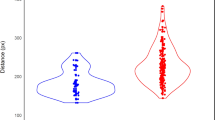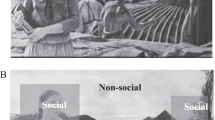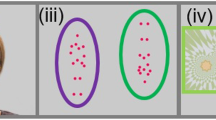Abstract
Visual fixation patterns whilst viewing complex photographic scenes containing one person were studied in 24 high-functioning adolescents with Autism Spectrum Disorders (ASD) and 24 matched typically developing adolescents. Over two different scene presentation durations both groups spent a large, strikingly similar proportion of their viewing time fixating the person’s face. However, time-course analyses revealed differences between groups in priorities of attention to the region of the face containing the eyes. It was also noted that although individuals with ASD were rapidly cued by the gaze direction of the person in the scene, this was not followed by an immediate increase in total fixation duration at the location of gaze, which was the case for typically developing individuals.






Similar content being viewed by others
References
American Psychiatric Association. (1994). Diagnostic and statistical manual of mental disorders (4th ed.). Washington, DC: American Psychiatric Association.
Baldwin, D. (1995). Understanding the link between joint attention and language acquisition. In C. Moore & P. Dunham (Eds.), Joint attention: Its origins and role in development. Hillsdale, NJ: Erlbaum.
Baron-Cohen, S. (1995). Mindblindness: An essay on autism and theory of mind. Cambridge, MA: MIT Press.
Baron-Cohen, S., Wheelwright, S., Hill, J., Raste, Y., & Plumb, I. (2001). The “Reading the Mind in the Eyes” test revised version: A study with normal adults, and adults with asperger syndrome or high-functioning autism. The Journal of Child Psychology and Psychiatry and Allied Disciplines, 42, 241–251.
Bayliss, A. R., & Tipper, S. P. (2005). Gaze and arrow cueing of attention reveals individual differences along the autism spectrum as a function of target context. British Journal of Psychology, 96, 95–114.
Birmingham, E., Bischof, W. F., & Kingstone, A. (2008). Social attention and real-world scenes: The roles of action, competition and social content. The Quarterly Journal of Experimental Psychology, 61(7), 986–998.
Boucher, R. P., & Lewis, V. (1992). Unfamilar face recognition in relatively able autistic children. Journal of Child Psychology and Psychiatry, 33, 843–859.
Bruner, J. (1983). Child’s talk: Learning to use language. Oxford: Oxford University Press.
Chawarska, K., Klin, A., & Volkmar, F. (2003). Automatic attention cueing through eye movement in 2-year-old children with autism. Child Development, 74(4), 1108–1122.
Chawarska, K., & Shic, F. (in press). Looking but not seeing: Atypical visual scanning and recognition of faces in 2 and 4-year-old children with Autism Spectrum Disorder. Journal of Autism and Developmental Disorders. doi:10.1007/s10803-009-0803-7.
Dalton, K. M., Nacewicz, B. M., Johnstone, T., Schafer, H. S., Gernsbacher, M. A., Goldsmith, H. H., et al. (2005). Gaze fixation and the neural circuitry of face processing in autism. Nature Neuroscience, 8, 519–526.
Dawson, G., Meltzoff, A. N., Osterling, J., & Rinaldi, J. (1998). Neuropsychological correlates of early symptoms of autism. Child Development, 69, 1276–1285.
Dawson, G., Toth, K., Abbott, R., Osterling, J., Munson, J., Estes, A., et al. (2004). Early social attention impairments in autism: Social orienting, joint attention, and attention to distress. Developmental Psychology, 40, 271–283.
Driver, J., Davis, G., Ricciardelli, P., Kidd, P., Maxwell, E., & Baron-Cohen, S. (1999). Gaze perception triggers reflexive visuospatial orienting. Visual Cognition, 6, 509–540.
Ehlers, S., Gillberg, C., & Wing, L. (1999). A screening questionnaire for asperger syndrome and other high-functioning autism spectrum disorders in school age children. Journal of Autism and Developmental Disorders, 29(2), 129–141.
Fletcher-Watson, S., Leekam, S. R., Benson, V., Frank, M. C., & Findlay, J. M. (2009). Eye-movements reveal attention to social information in autism spectrum disorder. Neuropsychologia, 47, 248–257.
Friesen, C. K., & Kingstone, A. (1998). The eyes have it! Reflexive orienting is triggered by nonpredictive gaze. Psychonomic Bulletin & Review, 5(3), 490–495.
Goren, C. C., Sarty, M., & Wu, P. Y. K. (1975). Visual following and pattern discrimination of face-like stimuli by newborn infants. Pediatrics, 56, 544–549.
Haith, M. M., Bergman, T., & Moore, M. J. (1979). Eye contact and face scanning in early infancy. Science, 198, 853–854.
Johnson, M., Dziurawiec, S., Ellis, H. D., & Morton, J. (1991). Newborns’ preferential tracking of face-like stimuli and its subsequent decline. Cognition, 40, 1–19.
Jones, W., & Klin, A. (2008). Altered salience in autism. In E. McGregor, M. Nuez, K. Cebula, & J. C. Gomez (Eds.), Autism: An integrated view from neurocognitive, clinical and intervention research (pp. 62–82). Oxford: Blackwell.
Joseph, R. M., & Tanaka, J. (2003). Holistic and part-based face recognition in children with autism. Journal of Child Psychology and Psychiatry, 44(4), 529–542.
Klin, A., Jones, W., Schultz, R., & Volkmar, F. (2003). The enactive mind, or from actions to cognition: lessons from autism. Philosophical Transactions of the Royal Society of London Series B-Biological Sciences, 358(1430), 345–360.
Klin, A., Jones, W., Schultz, R., Volkmar, F., & Cohen, D. (2002). Visual fixation patterns during viewing of naturalistic social situations as predictors of social competence in individuals with autism. Archives of General Psychiatry, 59(9), 809–816.
Langton, S. R. H., & Bruce, V. (1999). Reflexive visual orienting in response to the social attention of others. Visual Cognition, 6(5), 541–567.
Leekam, S. R., Hunnisett, E., & Moore, C. (1998). Targets and cues: Gaze-following in children with autism. Journal of Child Psychology and Psychiatry and Allied Disciplines, 39, 951–962.
Leekam, S. R., Lopez, B., & Moore, C. (2000). Attention and joint attention in preschool children with autism. Developmental Psychology, 36(2), 261–273.
Pelphrey, K. A., Sasson, N. J., Reznick, J. S., Paul, G., Goldman, B. D., & Piven, J. (2002). Visual scanning of faces in autism. Journal of Autism and Developmental Disorders, 32(4), 249–261.
Riby, D., & Hancock, P. J. B. (2008). Research note: Viewing it differently: social scene perception in Williams syndrome and autism. Neuropsychologia, 46, 2855–2860.
Ristic, J., Mottron, L., Friesen, C. K., Iarocci, G., Burack, J. A., & Kingstone, A. (2005). Eyes are special but not for everyone: The case of autism. Cognitive Brain Research, 24, 715–718.
Senju, A., Csibra, G., & Johnson, M. H. (2008). Understanding the referential nature of looking: Infants’ preference for object-directed gaze. Cognition, 108, 303–319.
Skuse, D. (2006). Genetic influences on the neural basis of social cognition. Philosophical Transactions of the Royal Society B: Biological Sciences, 361, 2129–2141.
Skuse, D. H. (2007). Rethinking the nature of genetic vulnerability to autistic spectrum disorders. Trends in Genetics, 23(8), 387–395.
Speer, L. L., Cook, A. E., McMahon, W. M., & Clark, E. (2007). Face processing in children with autism: Effects of stimulus contents and type. Autism, 11(3), 265–277.
Spezio, M. L., Adolphs, R., Hurley, R. S. E., & Piven, J. (2007). Abnormal use of facial information in high-functioning autism. Journal of Autism and Developmental Disorders, 37, 929–939.
Swettenham, J., Baron-Cohen, S., Charman, T., Cox, A., Baird, G., Drew, A., et al. (1998). The frequency and distribution of spontaneous attention shifts between social and non-social stimuli in autistic, typically-developing and non-autistic developmentally delayed infants. Journal of Child Psychology and Psychiatry, 39, 747–753.
Swettenham, J., Condie, S., Campbell, R., Milne, E., & Coleman, M. (2003). Does the perception of moving eyes trigger reflexive visual orienting in autism? Philosophical Transactions of the Royal Society of London Series B-Biological Sciences, 358(1430), 325–334.
van der Geest, J. N., Kemner, C., Verbaten, M. N., & van Engeland, H. (2002). Gaze behavior of children with pervasive developmental disorder toward human faces: A fixation time study. Journal of Child Psychology and Psychiatry, 43(5), 669–678.
Acknowledgments
This research would have been impossible without the kind cooperation of the staff, students, and parents involved in the studies. Participating schools included Aldercar Community Language College, Bigwood School, Bracken Hill, Bramcote Park and Enterprise School, Cruckton Hall, Foxwood, The Long Eaton School, Ysgol Plas Brondyffryn. This research was funded by a PhD studentship from the University of Nottingham, School of Psychology awarded to the first author and Economic and Social Research Council grant number PTA-026-27-2283.
Author information
Authors and Affiliations
Corresponding author
Rights and permissions
About this article
Cite this article
Freeth, M., Chapman, P., Ropar, D. et al. Do Gaze Cues in Complex Scenes Capture and Direct the Attention of High Functioning Adolescents with ASD? Evidence from Eye-tracking. J Autism Dev Disord 40, 534–547 (2010). https://doi.org/10.1007/s10803-009-0893-2
Published:
Issue Date:
DOI: https://doi.org/10.1007/s10803-009-0893-2




